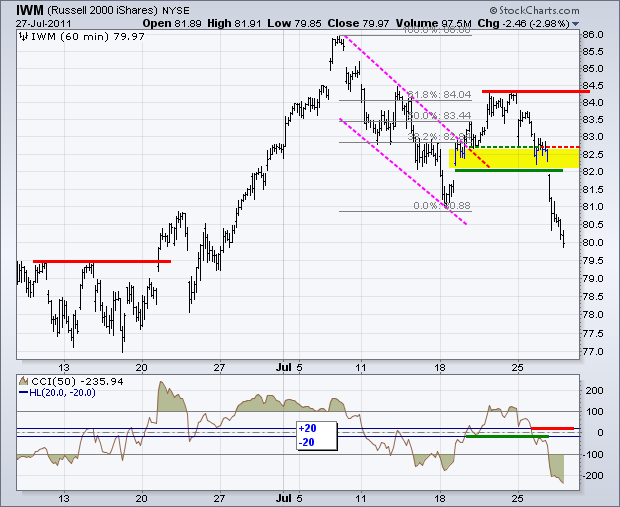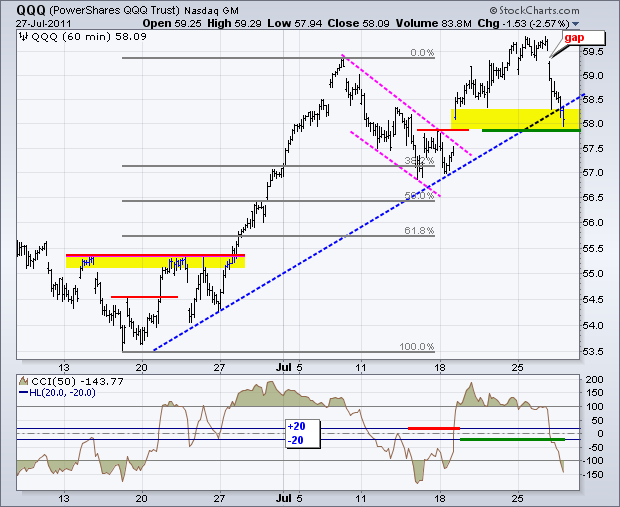Stocks moved sharply lower with a broad sell off that rocked all boats. All nine sectors were down. Small-caps and mid-caps led the way lower with declines in excess of 2%. Breadth plunged with the NYSE Net Advances Ratio reaching -.81 and the Nasdaq Net Advancing Volume Ratio hitting -.72, their lowest readings of the year. After an extended decline, this kind of selling pressure would be indicative of a selling climax that could foreshadow a low. However, Wednesday's big sell off occurred closer to resistance and after the July rally. This suggests more to come before we can expect support or a low. With big gaps and a continuation lower, the S&P 500 ETF (SPY) and the Russell 2000 ETF (IWM) clearly broke support to negate their breakouts. Momentum oscillators for these two ETFs also broke support to turn short-term momentum bearish. Broken supports and the gaps become the first resistance levels to watch (red dotted lines). For now, I will set key resistance at last week's high.

QQQ finished the day in its support zone and has yet to actually break down. It is, however, hard to imagine QQQ bucking the trend of the majority, even with the Apple express. CCI moved below -20 to turn momentum bearish.

The stock market appears more concerned about the debt-ceiling debacle than the bond market. Go figure. Actually, I think stocks were reacting to two negative economic reports (Durable Goods and the Fed Beige Book). Signs of economic weakness are bullish for bonds because it means the Fed will keep the monetary floodgates open, regardless of inflationary pressures. The price chart remains unchanged for the 20+ year Bond ETF (TLT). A falling wedge has formed as the ETF holds support in the 95 area. Look for a break above 96.25 to reverse the short-term downtrend.

The US Dollar Fund (UUP) got its oversold bounce with a move back to 21.10 on Wednesday. So far this just looks like an oversold bounce with resistance coming into play soon. Broken supports around 21.20 and 21.35 combine to mark a resistance zone. The July trendline confirms the upper end of this resistance zone, which can be considered key resistance. A breakout is needed to reverse the short-term downtrend.

Strength in the Dollar and weakness on the stock market combined to push oil lower on Wednesday. The 12-Month US Oil Fund (USL) broke first support at 44.50 and moved below the wedge trendline. At this point, I consider this a minor support break or the first bearish signal. There is still a significant support zone around 43.25-43.50. A lot will depend on the stock market and the Dollar. Further weakness in stocks and strength in the Dollar would likely weigh on crude.

There is no change in the Gold SPDR (GLD). The ETF broke triangle resistance on Friday and continued higher on Monday. Broken resistance turns into first support. Last week's lows mark key support.

Key Economic Reports:
Thu - Jul 28 - 08:30 - Jobless Claims
Fri - Jul 29 - 08:30 - GDP
Fri - Jul 29 - 09:45 - Chicago Purchasing Managers Index (PMI)
Fri - Jul 29 - 09:55 - Michigan Sentiment
Charts of Interest: Tuesday and Thursday in separate post.
This commentary and charts-of-interest are designed to stimulate thinking. This analysis is not a recommendation to buy, sell, hold or sell short any security (stock ETF or otherwise). We all need to think for ourselves when it comes to trading our own accounts. First, it is the only way to really learn. Second, we are the only ones responsible for our decisions. Think of these charts as food for further analysis. Before making a trade, it is important to have a plan. Plan the trade and trade the plan. Among other things, this includes setting a trigger level, a target area and a stop-loss level. It is also important to plan for three possible price movements: advance, decline or sideways. Have a plan for all three scenarios BEFORE making the trade. Consider possible holding times. And finally, look at overall market conditions and sector/industry performance.

